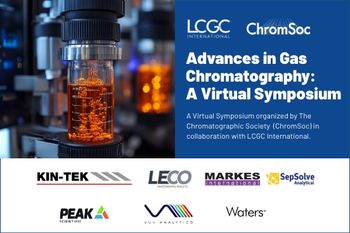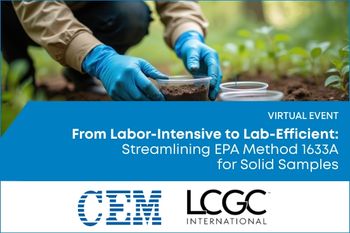
E-Separation Solutions
- E-Separation Solutions-07-15-2008
- Volume 0
- Issue 0
Ask the Editor: The Effect of Environmental Factors on Degradation of High Purity Solvents
How are HPLC solvents affected by exposure to light, heat, and humidity? What are the best procedures for short-term storage of HPLC solvents and buffers to avoid degradation?
The answer to the following question was provided by Dr. Jim Przybytek of Honeywell Burdick and Jackson.
How are HPLC solvents affected by exposure to light, heat, and humidity? What are the best procedures for short-term storage of HPLC solvents and buffers to avoid degradation?
Most high purity solvents are stable molecules that typically do not degrade significantly with time. The greatest cause of degradation can usually be attributed to environmental factors. Because of this, solvent storage conditions can be important. Major environmental factors are temperature extremes, exposure to light, and humidity.
Temperature extremes: High temperatures accelerate any degradation reactions. Temperature fluctuations create changes in pressure that can affect seal integrity and allow the package security to be compromised, allowing introduction of air or moisture to the product. The level of water content itself is a specification parameter and water level might affect degradation reactions. Air can accelerate certain reactions such as product oxidation. Maximum temperature extremes could be from -20 to +50 °C, but most reagents and solvents are stored between 10 °C and 40 °C.
Exposure to light: Light energy can theoretically initiate certain reactions by generation of trace amounts of free radicals or if is absorbed by a chromophore in the molecule. Exposure to ionizing radiation itself is not likely. Typical solvents do not absorb strongly in the visible region, so the effects of light are expected to be minimal, but storage for extended periods of time in direct sunlight is not recommended. Solvents are typically packaged in materials that limit light penetration such as amber glass or metal. Polyethylene type containers or outer shells, while not totally opaque or tinted, still limit light energy through the milky container walls and block UV radiation. Most of these are shipped in opaque outer shipping cartons. High purity water and water-based blends are a special case. They are susceptible to bacterial contamination and proliferation that generates contamination caused by metabolites. In some cases visible light may exacerbate the problem. This is most likely after the container is opened. Opened containers should be used promptly or the unused material disposed after a short time.
Humidity: Relative humidity can vary to near 100%, and some solvents can absorb moisture in higher humidity conditions. The seal on the container is critical in this case. All seals offer reasonable protection from humidity, and major effects are seen in extended storage under high humidity, but only affect products with extremely low water content, such as anhydrous grade or products with low water content (less than 100 ppm).
Less stable solvents: Solvents that contain the ether linkage and some esters and hydrocarbons may develop peroxides as contaminants. This can lead to generation of further decomposition products. Halocarbons can be susceptible to free radical degradation. For these less stable solvents, a trace inhibitor or preservative is added, usually chosen to maximize stability and minimize interference with specific applications.
Solvent blends: Blends may contain mixtures of pure components that may be somewhat reactive. Although most commercially available blends are relatively stable, some combinations may be less stable due to inherent reactivity, such as blends of formic acid and methanol.
Shelf life testing and stress testing: Any shelf life testing requires documentation of temperature and humidity conditions via data loggers. Stress testing of the solvent or reagent can be useful to help identify the likely degradation products, which can in turn help establish the degradation pathways and the intrinsic stability of the molecule. We [Honeywell Burdick and Jackson] have not conducted extensive scientific stress testing of high purity solvents. The nature of the stress testing would depend on the individual solvent and the potential reactivity of the molecule. Stress testing should include the effect of extremes of temperatures, humidity, oxidation, and photolysis on the solvent or reagent. Most of the conclusions we have drawn are based on anecdotal evidence including feedback from customers over a number of years.
Solvent storage recommendations: Solvents should be stored in a temperature-controlled area near room temperature. Wide temperature fluctuations should be avoided. Some degradation can occur if the solvent comes into contact with air or humidity. Except for the sealed stainless steel pressure dispense system (SSPDS) containers, after the package is opened and some solvent is removed, there is more opportunity for slow degradation by contact with air or absorption of water. Topping the opened container with an inert gas such as nitrogen or argon can help to minimize the effects of oxygen.
Questions?
LCGC technical editor Steve Brown will answer your technical questions. Each month, one question will be selected to appear in this space, so we welcome your submissions. Please send all questions to the attention of "Ask the Editor" at
Articles in this issue
over 17 years ago
Technology Forum: Sample Prepover 17 years ago
Efficient Analysis of Biodiesel by HPLC and ELSDover 17 years ago
Market Profile: Indiaover 17 years ago
Branching in High Molar Mass Synthetic Amylosesover 17 years ago
GPC/SEC Characterization of GelatinNewsletter
Join the global community of analytical scientists who trust LCGC for insights on the latest techniques, trends, and expert solutions in chromatography.




